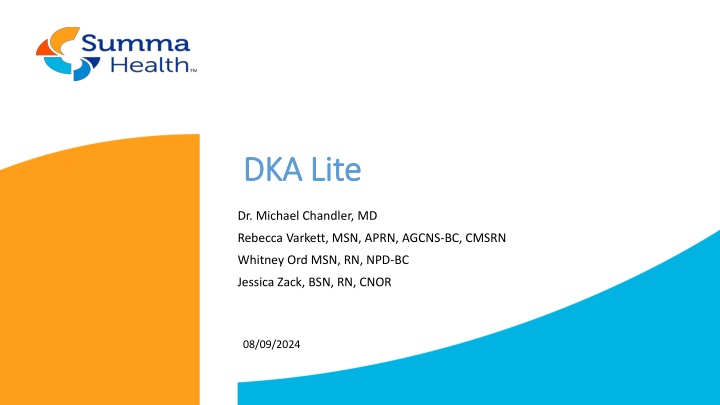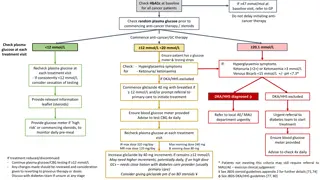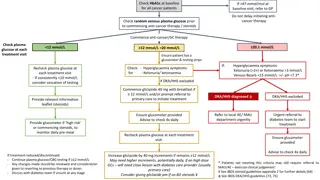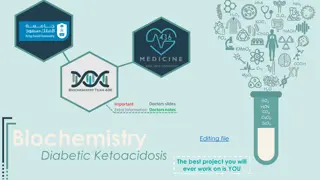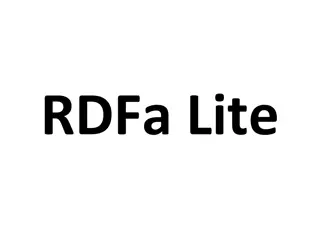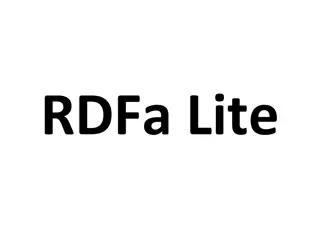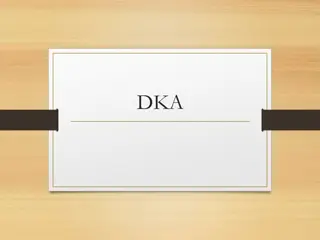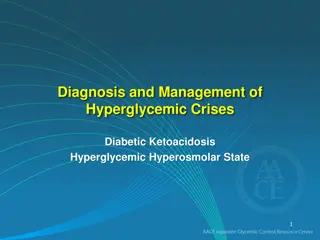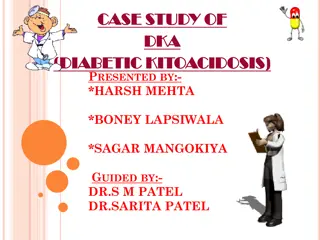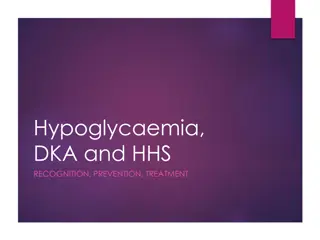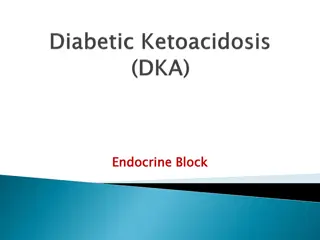DKA Lite
Diabetic Ketoacidosis (DKA) is a serious complication of diabetes that can be managed effectively with the DKA Lite approach, offering subcutaneous insulin therapy for mild cases. Understanding the pathophysiology, clinical manifestations, and treatment options is essential for healthcare providers. Learn about DKA Lite's benefits, criteria, and implementation in reducing complications and improving patient outcomes.
Download Presentation

Please find below an Image/Link to download the presentation.
The content on the website is provided AS IS for your information and personal use only. It may not be sold, licensed, or shared on other websites without obtaining consent from the author.If you encounter any issues during the download, it is possible that the publisher has removed the file from their server.
You are allowed to download the files provided on this website for personal or commercial use, subject to the condition that they are used lawfully. All files are the property of their respective owners.
The content on the website is provided AS IS for your information and personal use only. It may not be sold, licensed, or shared on other websites without obtaining consent from the author.
E N D
Presentation Transcript
DKA Lite DKA Lite Dr. Michael Chandler, MD Rebecca Varkett, MSN, APRN, AGCNS-BC, CMSRN Whitney Ord MSN, RN, NPD-BC Jessica Zack, BSN, RN, CNOR 08/09/2024
Agenda 1. Diabetic Ketoacidosis (DKA) Pathophysiology and Etiology Clinical Manifestations Laboratory Findings Treatment 3. Current Policy and Procedures 4. Implementation of DKA Lite (Insulin administered via subcutaneous injection vs an IV drip for Mild DKA). 5. Discharge Education Resources 8/9/24 2
Diabetic Ketoacidosis (DKA) DKA develops in patients with no insulin reserves, typically patients with Type 1 Diabetes Mellitus. o DKA results in ketone formation from the absence of self-made insulin. Due to the lack of available insulin, the body is unable to convert glucose into energy (glycolysis). Liver breaks down fat for energy instead of glucose = ketones Creating ketoacidosis and hyperglycemia DKA is less common in Type 2 Diabetic patients because, in most cases, there is some self- made insulin that is conducive in preventing lipolysis from occurring. Diabetic ketoacidosis in adults | The BMJ 3
What is Diabetic ketoacidosis (DKA)? Serum Glucose > 250 Acute development (typically s/s development within 24hrs) High Anion Gap Serum Anion Gap = Serum Na+ (Cl + HCO3) + Ketone Bodies: 1. Acetoacetic acid 2. Beta-hydroxybutyric Acid (BHB) 3. Acetone Body lacks enough insulin to convert sugar into energy. The liver then breaks down fats for energy instead of sugar = ketones Causes: illness, cardiac event S/S: Fruity-smelling breath, high ketone levels in urine Clinical Treatment: Fluids Insulin therapy/blood glucose monitoring Correction of electrolyte imbalance Treat underlying medical condition (cause of DKA) 08/09/24 4
What is DKA Lite?- DKA lite is treatment of Mild DKA using subcutaneous insulin therapy Mild DKA Severe DKA Beta-Hydroxybutyrate (BHB) Positive Positive pH 7.2 to 7.29 Less than 7.2 Anion Gap 14 to 24 Greater than 24 Potassium Greater than or equal to 3.3 Less than 3.3 BMP HCO3 11 to 18 Less than or equal to 10 DKA lite Subcutaneous insulin therapy DKA Intravenous IV insulin therapy Mild DKA Severe DKA GFR Greater or equal to 30 ml/min Less than 30 ml/min Pregnant No Yes Potassium Greater than or equal to 3.3 Less than 3.3 MAP Greater than or equal to 65 mmHg Less than 65 mmHg Weight Less than or equal to 166 kg Greater than 166 kg Mental Status Alert Obtunded Level of Care PCU ICU 5 08/09/2024
DKA Lite Offers new subcutaneous path for uncomplicated DKA patients Patients with mild DKA can safely be managed in a progressive care unit (PCU) with subcutaneous insulin therapy along with monitoring of lab values and symptoms DKA Lite: Reduces complications related to increased length of stay Reduces boarding time in the ED Hospitalists will manage the care of a patient requiring DKA Lite therapy Special considerations that require an Endocrinology consult: if patient requires U-500, patient has home insulin pump, and/or if treatment exceeds greater than 24 hours. Complications Patient Outcomes 6 08/09/2024
GOAL: Anion Gap less than 12 mmol/L and BHB less than or equal to 10 mg/dL DKA Lite Treatment Patients experiencing DKA are very dehydrated. Large amounts of fluid replacement is required, including special populations. Special populations, include; chronic kidney disease (CKD) and/or heart failure Monitor and notify provider with symptoms of fluid volume overload such as, changes to respiratory assessment or increase oxygen requirements If DKA lite treatment exceeds 24 hours, Endocrinology should be consulted to evaluation treatment. If DKA Lite interventions exceed 24 hours the patient may need higher level of care. Electrolyte imbalance with DKA requires potassium, magnesium, and phosphorus replacement Frequent monitoring of lab values 7 10.6.2023
GOAL: Anion Gap less than 12 mmol/L and BHB less than or equal to 10 mg/dL Monitor Lab Values Every 2 hours: Blood glucose point of care testing (POCT) Every 4 hours: BMP, Mag, Phosphorus, Venous Blood Gas (VBG), and Beta Hydroxybutyrate (BHB) Arterial pH: 7.2-7.29 or LESS: ketones enter the bloodstream causing blood to become more acidic. Anion Gap: 14-24 or GREATER: measures the balance of electrolytes in your blood; the greater the number, the more acidic. BMP HCO3: 10 or LESS: a decrease in blood pH and HCO3 concentration due to ketoacid production. Human Chorionic Gonadotropin (HCG): POSITIVE Is the patient currently pregnant? Serum Ketones - Beta Hydroxybutyrate: Predominant ketone body at the onset of DKA related to starvation. 8 10.6.2023
DKA Lite Order Set Utilize the order set built to support the evidence-based management of DKA using subcutaneous insulin. Reminder: High amounts of fluids and insulin are critical for treating DKA 9 08/09/2024 Summa Health Sample Preso
Management of DKA requires insulin doses that exceeds Epic recommended maximum per day. This alert is not intended for the treatment of DKA. DO NOT CHANGE. 10 08/09/2024 Summa Health Sample Preso
GOAL: Anion Gap less than 12 mmol/L and BHB less than or equal to 10 mg/dL Discontinue all DKA lite order set orders once the GOAL is met. *TIP Select the purple number to link the order set orders for easy discontinuation! 11 08/09/2024 Summa Health Sample Preso
When following the order set, patients typically reach the goal with in 24 hours. If goal is not met with in 24 hours, consult Endocrinology. 12 08/09/2024 Summa Health Sample Preso
